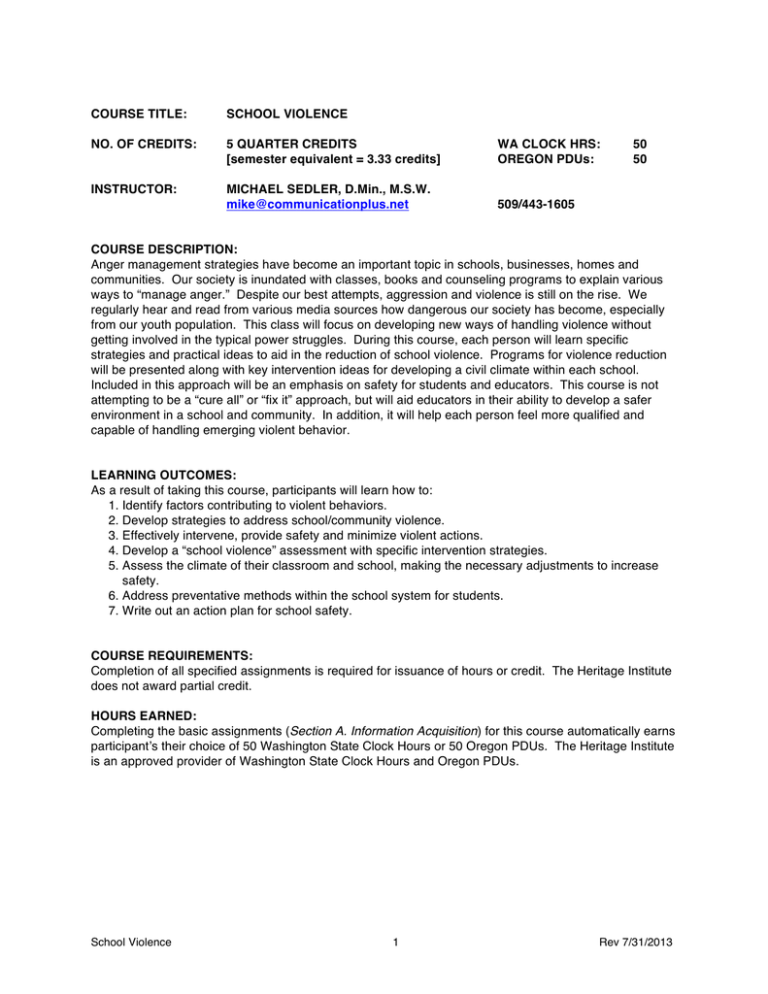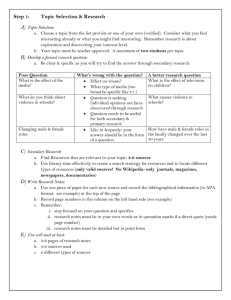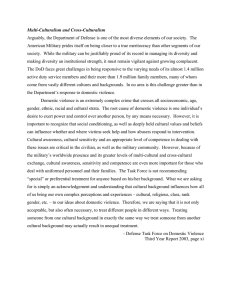COURSE TITLE: SCHOOL VIOLENCE NO. OF CREDITS:
advertisement

COURSE TITLE: SCHOOL VIOLENCE NO. OF CREDITS: 5 QUARTER CREDITS [semester equivalent = 3.33 credits] WA CLOCK HRS: OREGON PDUs: INSTRUCTOR: MICHAEL SEDLER, D.Min., M.S.W. mike@communicationplus.net 509/443-1605 50 50 COURSE DESCRIPTION: Anger management strategies have become an important topic in schools, businesses, homes and communities. Our society is inundated with classes, books and counseling programs to explain various ways to “manage anger.” Despite our best attempts, aggression and violence is still on the rise. We regularly hear and read from various media sources how dangerous our society has become, especially from our youth population. This class will focus on developing new ways of handling violence without getting involved in the typical power struggles. During this course, each person will learn specific strategies and practical ideas to aid in the reduction of school violence. Programs for violence reduction will be presented along with key intervention ideas for developing a civil climate within each school. Included in this approach will be an emphasis on safety for students and educators. This course is not attempting to be a “cure all” or “fix it” approach, but will aid educators in their ability to develop a safer environment in a school and community. In addition, it will help each person feel more qualified and capable of handling emerging violent behavior. LEARNING OUTCOMES: As a result of taking this course, participants will learn how to: 1. Identify factors contributing to violent behaviors. 2. Develop strategies to address school/community violence. 3. Effectively intervene, provide safety and minimize violent actions. 4. Develop a “school violence” assessment with specific intervention strategies. 5. Assess the climate of their classroom and school, making the necessary adjustments to increase safety. 6. Address preventative methods within the school system for students. 7. Write out an action plan for school safety. COURSE REQUIREMENTS: Completion of all specified assignments is required for issuance of hours or credit. The Heritage Institute does not award partial credit. HOURS EARNED: Completing the basic assignments (Section A. Information Acquisition) for this course automatically earns participantʼs their choice of 50 Washington State Clock Hours or 50 Oregon PDUs. The Heritage Institute is an approved provider of Washington State Clock Hours and Oregon PDUs. School Violence 1 Rev 7/31/2013 UNIVERSITY QUARTER CREDIT INFORMATION REQUIREMENTS FOR UNIVERSITY QUARTER CREDIT Continuing Education Quarter credits are awarded by Antioch University Seattle (AUS). AUS requires 75% or better for credit at the 400 level (Upper Division) and 85% or better to issue credit at the 500 level (Post-Baccalaureate). These criteria refer both to the amount and quality of work submitted. 1. Completion of Information Acquisition assignments 30% 2. Completion of Learning Application assignments 40% 3. Completion of Integration Paper assignment 30% CREDIT/NO CREDIT (No Letter Grades or Numeric Equivalents on Transcripts) Antioch University Seattle (AUS) Continuing Education (CE) Quarter credit is offered on a Credit/No Credit basis; neither letter grades nor numeric equivalents are on a transcript. 400 level credit is equal to a “C” or better, 500 level credit is equal to a “B” or better. This information is on the back of the transcript. AUS CE quarter credits may not be accepted into degree programs. Prior to registering determine with your district, department head or state education office the acceptability of these credits for your purpose. ADDITIONAL COURSE INFORMATION NOTES: • You may work collaboratively with other teachers and submit joint assignments on all but the final Integration Paper, which must be individually authored and submitted. • Alternatives to written assignments (video or audio tape, photo collage, a collection of products, letters to editor, brochure and Web pages) may be submitted as substitute assignments with the instructorʼs prior approval. • To maintain privacy, please do not refer to students in your papers by their actual names, but rather use an alias or designation such as “Student A.” REQUIRED TEXT: • Chosen text from bibliography plus all handout materials, case study, and samples. Text may be purchased directly from publishing companies. List of all companies and phone numbers are located in the back of the student manual. MATERIALS FEE: • Once you register, log onto the instructorʼs website at www.michaelsedler.com. Click on Classes, then scroll down and click on School Violence manual. The manual will download as a PDF file to your computer. HEADING REQUIRED FOR ALL ASSIGNMENTS A heading is required; please use the following format. Your Name: Course Number: Date: Assignment #: School Violence Instructor Name: Course Name: Level: Clock/ PDU/ Credit (400 or 500) 2 Rev 7/31/2013 ASSIGNMENTS FOR HOURS OR UNIVERSITY QUARTER CREDIT Within each workbook, there will be an Assignment Checklist to be carefully followed. A. INFORMATION ACQUISITION Assignment #1: Read all materials in the manual sent by instructor. Assignment #2: Read a book from the bibliography or one of your choice (with instructor approval). Once you have read the book, respond to the following questions: • What area of the book do you plan to implement in your teaching or life approach? • Share one specific area of learning that was new to you. • If you were going to share this book with another person, who would that be and why? Send to instructor: mike@communicationplus.net. Subject to read: ʻViolence #2ʼ. Assignment #3: Review literature (minimum of four magazines, journals) on general topic of school violence/ aggression. Create an annotated bibliography. The annotation should include Title, Author, Publisher (or URL), length of the article and a paragraph review of information contained. Add your opinion of the value of the contents of each article. Send to instructor: mike@communicationplus.net. Subject to read: ʻViolence #3ʼ. Assignment #4: Identify general school violence and violent behaviors in your school or community. Write a 1-2 page paper. Send to instructor: mike@communicationplus.net. Subject to read: ʻViolence #4ʼ. Assignment #5: Keep a log over a two week period, three entries per week. Find articles in newspapers, listen to radio or television reports, or read in magazines areas discussing school violence. Formulate a number of questions that engage one group from the school community (students/teachers/administrators/businesses/taxpayers) in deeper thinking about ideas and strategies from this course. Send to instructor: mike@communicationplus.net. Subject to read: ʻViolence #5ʼ. Assignment #6: Investigate the history of your school in the area of violence. Was it different last year? 5 years ago? 10 years ago? Write a 1-2 page comparison paper with your ideas on what has changed. Send to instructor: mike@communicationplus.net. Subject to read: ʻViolence #6ʼ. Assignment #7: Discuss with a non-educator the concerns they have for violence in the community and school setting. Record your observations. (For use in #8) Assignment #8: Contact a supervisor (principal, superintendent, etc.) and discuss their concerns for violence in the community and school setting. Compare and contrast the non-educator answers with educator answers. Write a 1-2 page paper. Send to instructor: mike@communicationplus.net. Subject to read: ʻViolence #8ʼ. School Violence 3 Rev 7/31/2013 Assignment #9: Complete all forms found in the manual. Send specified forms to the instructor: mike@communicationplus.net. Subject to read: ʻViolence #9ʼ. This completes the assignments required for Hours Continue to the next section for additional assignments required for University Quarter Credit ADDITIONAL ASSIGNMENTS REQUIRED FOR UNIVERSITY QUARTER CREDIT B. LEARNING APPLICATION In this section you will apply your learning to your professional situation. This course assumes that most participants are classroom teachers who have access to students. If you are not teaching in a classroom, please contact the instructor for course modifications. If you are a classroom teacher and start or need to complete this course during the summer, please try to apply your ideas when possible with youth from your neighborhood, at a local public library or parks department facility, (they will often be glad to sponsor community-based learning), or with students in another teacherʼs summer classroom in session. Assignment #10: (Required for 400 and 500 Level) Using the “change process” format, write out specific areas of growth, suggestions and a plan to develop a climate of civility in your school. Write a 2-3 page paper. Send to instructor: mike@communicationplus.net. Subject to read: ʻViolence #10ʼ. Assignment #11: (Required for 400 and 500 Level) Share the above plan with a supervisor, administrator or colleague. 500 LEVEL ASSIGNMENT Assignment #12: (500 Level only) In addition to the 400 level assignments, complete one (1) of the following assignment options: Option A) Using the text read for the class, compare and contrast ideas, suggestions and interventions found in the book with those areas being presented by your district or community. Write a 2-3 page paper. Send to instructor: mike@communicationplus.net. Subject to read: ʻViolence #12ʼ. OR Option B) Contact a fellow educator from another district or community. Discuss the program ideas utilized in their school setting. Compare this to what you know of your district or community. Write a 2-3 page paper. Send to instructor: mike@communicationplus.net. Subject to read: ʻViolence #12ʼ. School Violence 4 Rev 7/31/2013 C. INTEGRATION PAPER (Required for 400 and 500 Level) Assignment #13: Write a 2-3 page Integration Paper answering these questions: 1. What did you learn vs. what you expected to learn from this course? 2. What aspects of the course were most helpful and why? 3. What further knowledge and skills in this general area do you feel you need? 4. How, when and where will you use what you have learned? 5. How and with what other school or community members might you share what you learned? Send to instructor: mike@communicationplus.net. Subject to read: ʻViolence #13ʼ. INSTRUCTOR COMMENTS ON YOUR WORK: Please indicate by email to the instructor if you would like to receive comments on your assignments. QUALIFICATIONS FOR TEACHING THIS COURSE: Michael Sedler, D.Min., M.S.W. brings over 25 years of educational experience as an administrator, social worker, behavior specialist and teacher to each of his classes. He provides consultation and seminars throughout the Northwest and Canada for schools, agencies and businesses. He has a graduate degree in Social Work, a Doctor in Ministry degree as well as his teaching certification. All of Mikeʼs classes are practical and “field tested” in schools and classrooms. Educators have found success in implementing Mikeʼs clear and concise approaches. School Violence 5 Rev 7/31/2013 SCHOOL VIOLENCE BIBLIOGRAPHY You may pick a book not from the list, with the instructorʼs approval. To order a book, contact the publisher or purchase through a bookstore, on-line, or other retail outlets. And Words Can Hurt Forever. James Garbarino and Ellen Delara. Free Press, 2003. Protect Adolescents from bullying, harassment, and violence. (grades 7-12) www.freepress.net 877-888-1533. Early Violence Prevention. Ron Slaby. Education Development Center. 1995.Tools for teachers and young children in area of violence (grades K–3) www.edc.org (617) 969-7100,ext. 2315 or (800) 3321002. Effective Responses to School Violence. Tony Jones. C.C. Thomas Publishing, 2001. Discusses security issues and needs in schools. (grades 5 – 12) www.ccthomas.com 800-258-8980. Ensuring Safe School Environments. Mary Susan Fishbaugh. Lawrence Erlbaum Associates, 2002. Research findings and information on school violence. (grades K -12) www.routledge.com Handbook of School Violence. Edwin Gerler. Haworth Press, 2004. General presentation of interventions and strategies. (grades K – 12) www.haworthpress.com 800-429-6784. Healing the Hate. Karen McLaughlin and Kelly Brilliant. Education Development Center. 1997. 10 unit curriculum focused on reducing hate crimes. (grades K – 12) www.edc.org (800) 332-1002. Janeʼs Safe School Planning Guide For All Hazards. Greg Dorn, Marleen Wong. Janeʼs Information Group, 2004. A general planning guide to various problems, disasters, and school concerns. (grades K – 12; adult) www.janes.com Odd Girl Out. Rachel Simmons. Harcourt Books. 2005. Understanding the culture of aggression in girls. (grades 7 – 12) www.harcourtbooks.com 800-543-1918. Peacezone Curriculum Series. Deborah Prothrow-Stith, Jon Oliver, and Joseph Chery. Research Press. 2005. Program for teaching social relationships. (grades K–8) www.researchpress.com 800) 519-2707. Preventing Violence in Schools. Joan Burstyn. Lawrence Erlbaum Associates, 2001. In depth look at school violence programs. (grades K – 12) www.routledge.com School Violence: Fears vs. Facts. Stephanie Spina. Lawrence Erlbaum Associates, 2006. Case studies used to illustrate assessment and interventions. (grades K – 12) www.routledge.com School Violence Intervention. Jane Conoly and Arnold Goldstein. The Guilford Press, 2004. Analysis of school violence and proactive interventions. (grades K – 12) www.guilford.com 800-365-7006. Violence in American Schools. R. Murray Thomas. Praeger Publishers, 2006. Discusses escalation in violence, motivation, and interventions. (grades 7 – 12) www.praeger.com 800- 225-5800 Violence in Schools. Kathy Sexton-Radek. Praeger Publishers, 2004. Academic explanation of the history and treatment of violence in schools. (grades K -12) www.praeger.com 800- 225-5800 School Violence 6 Rev 7/31/2013


